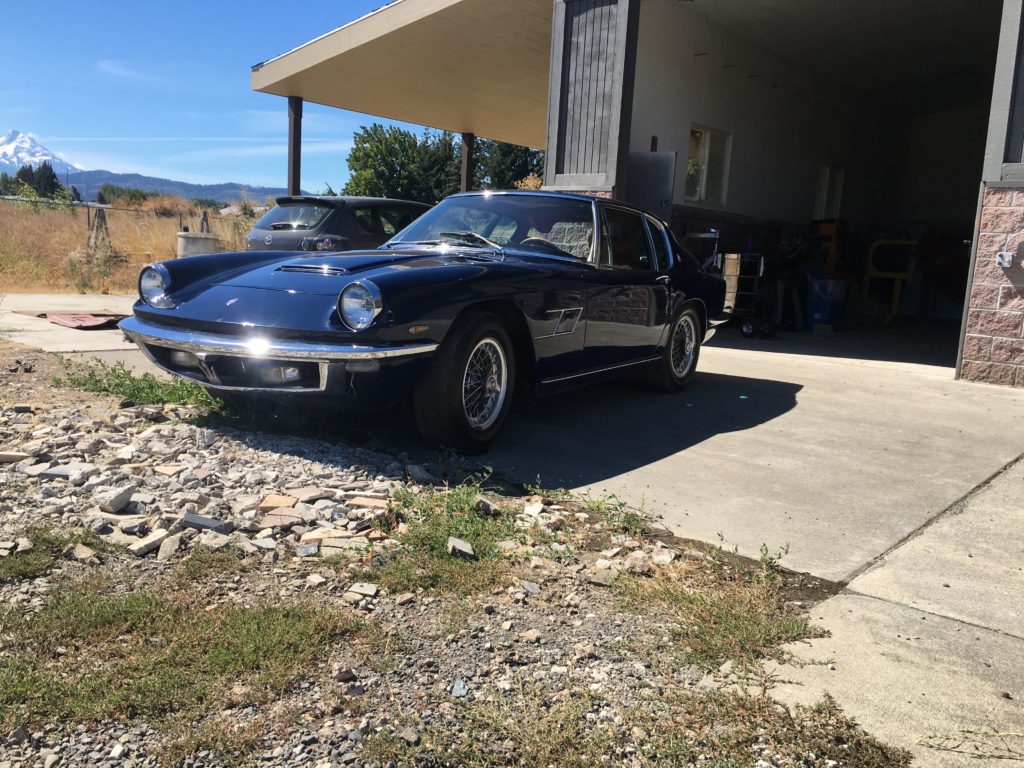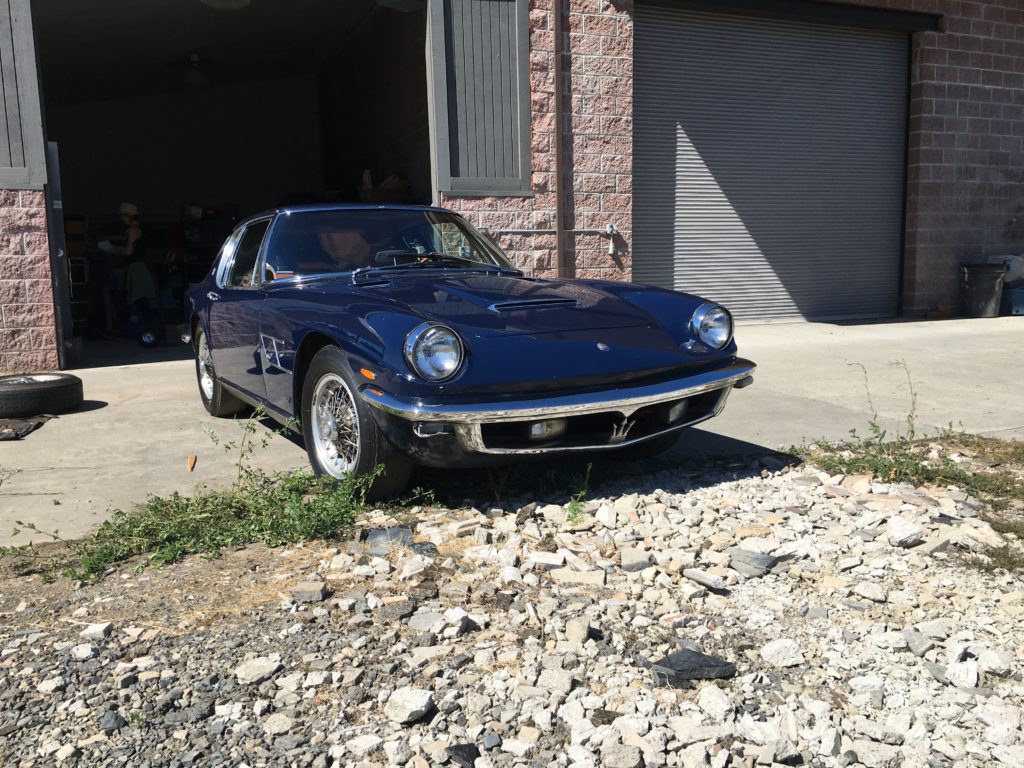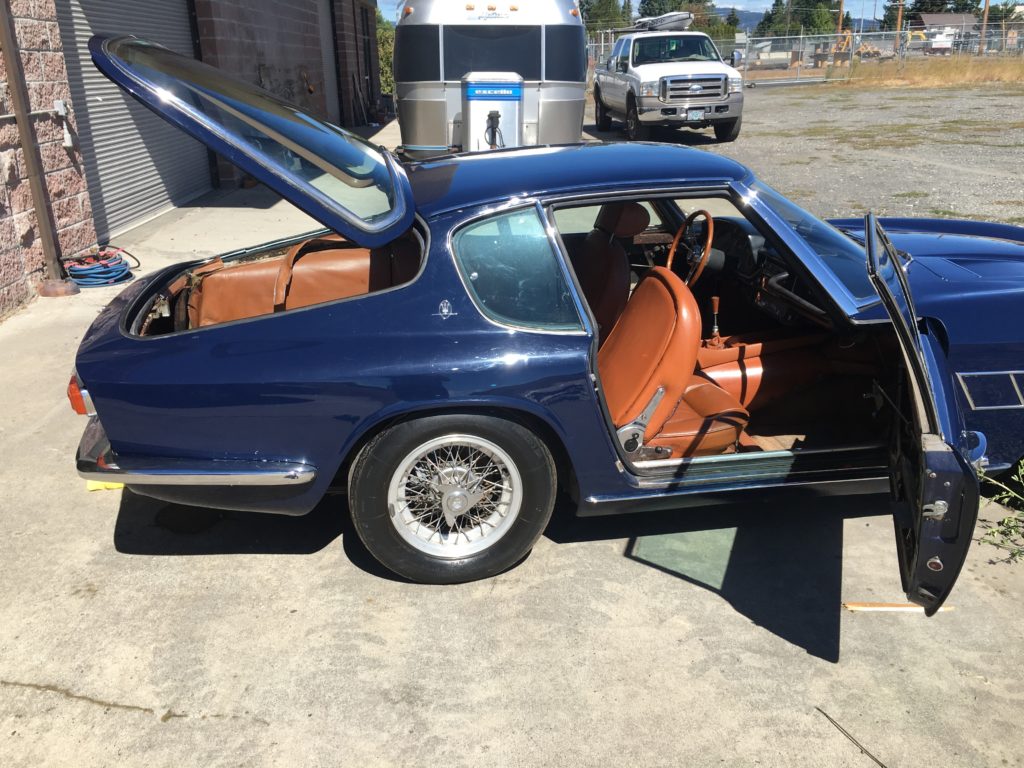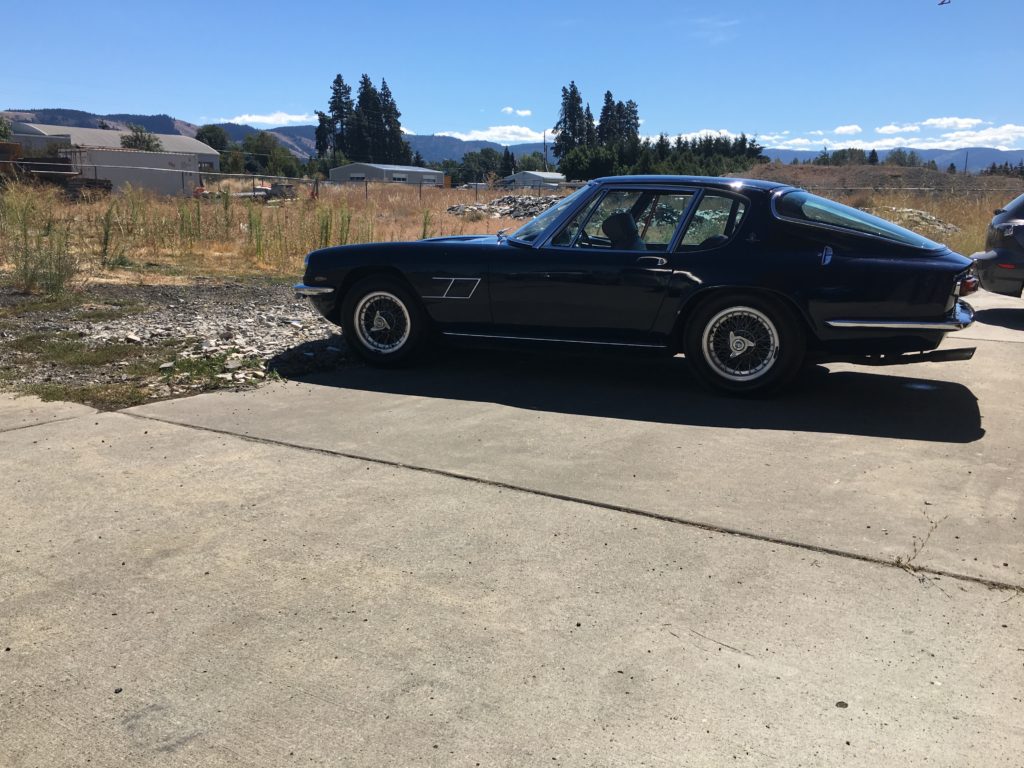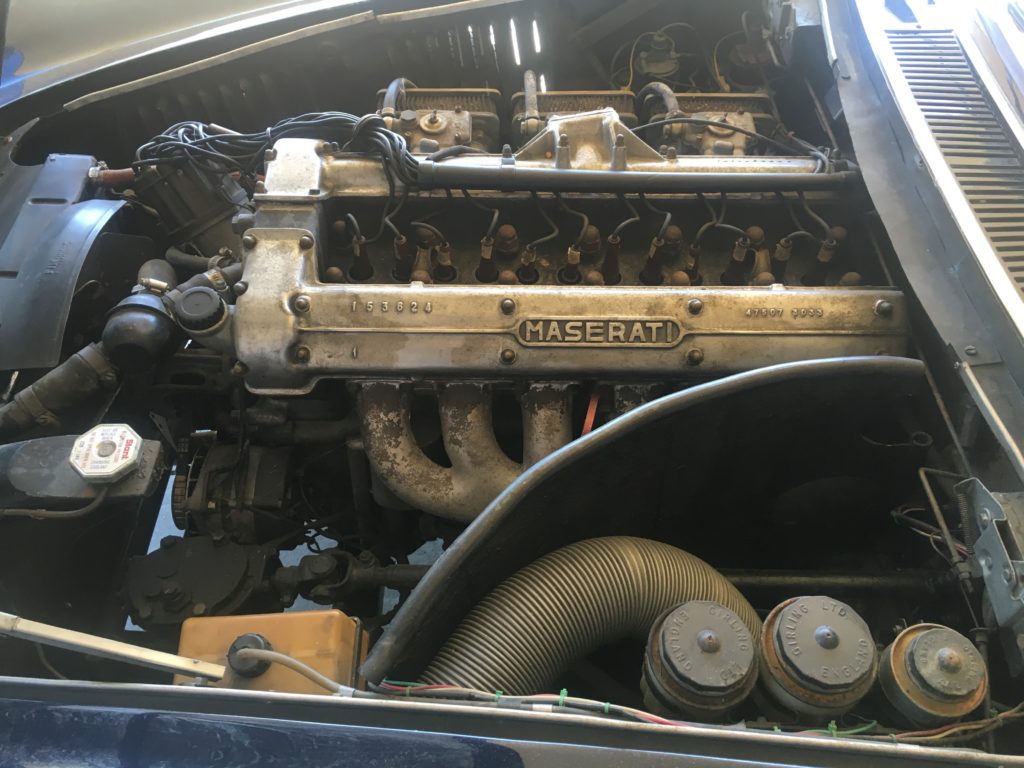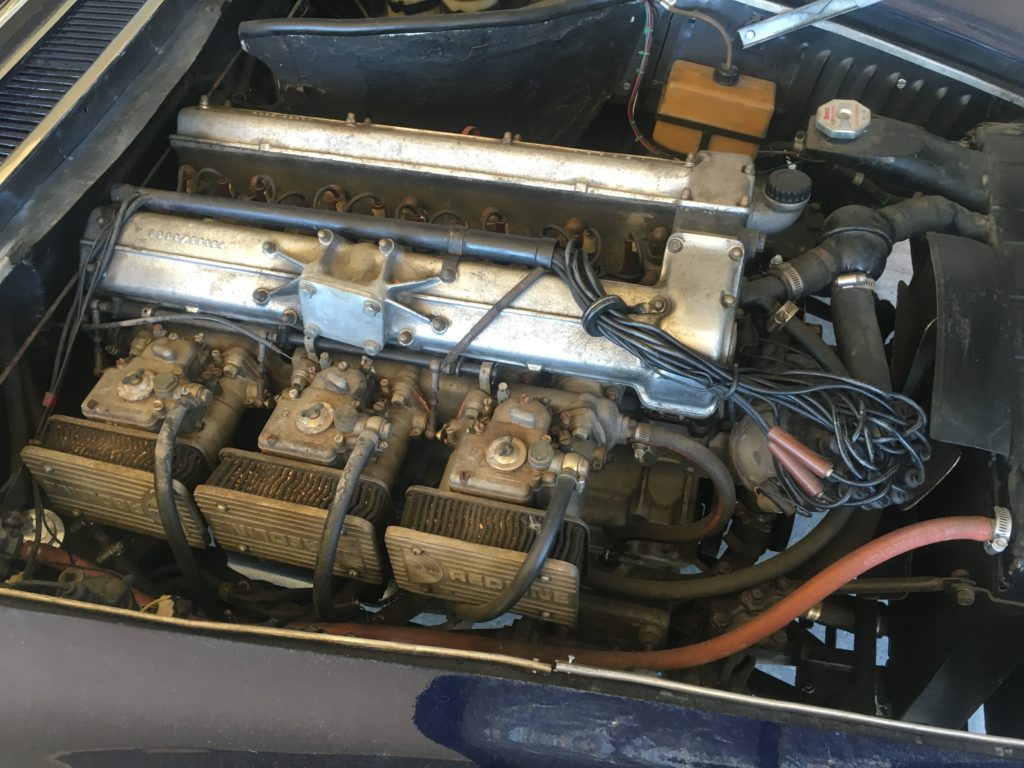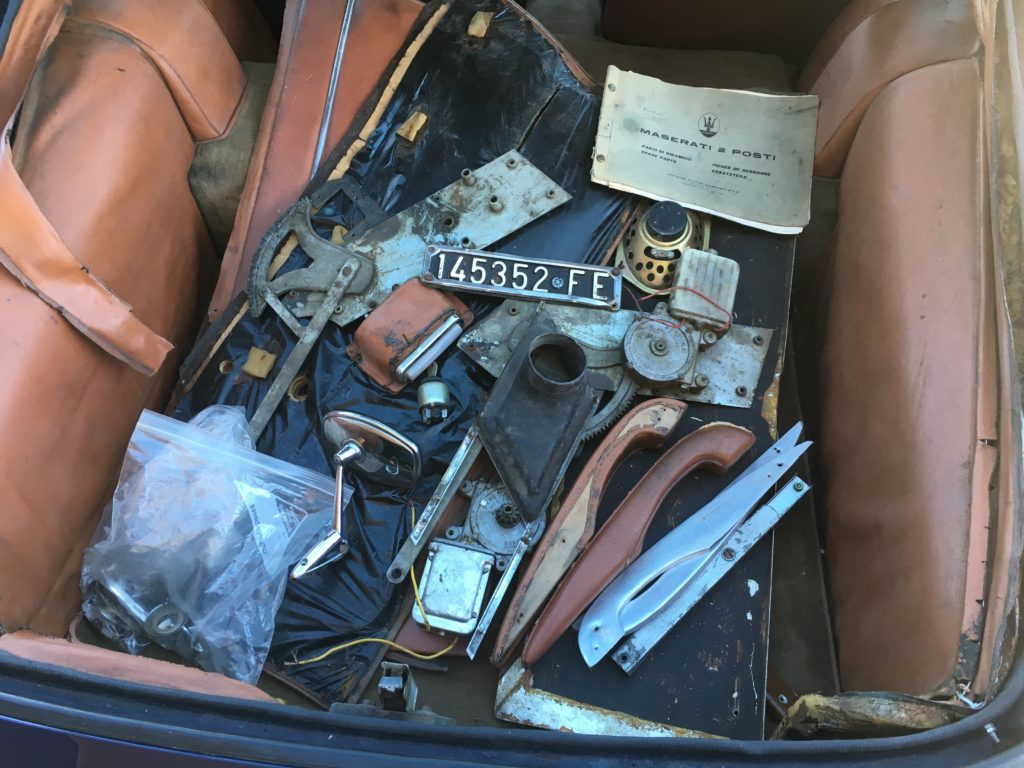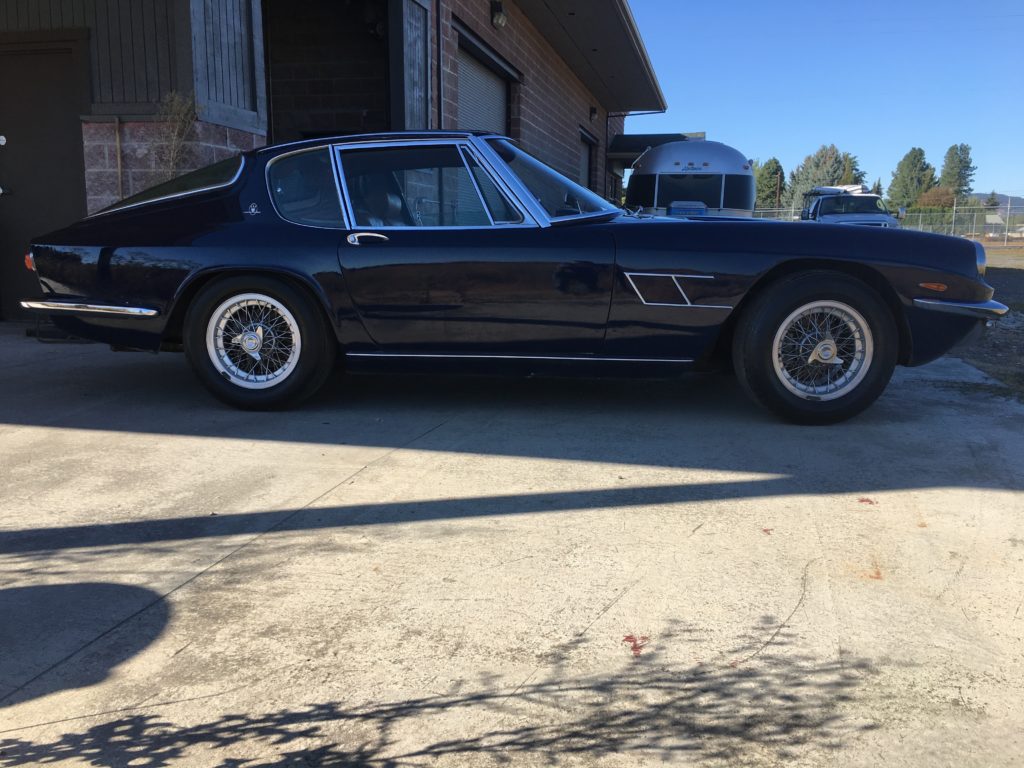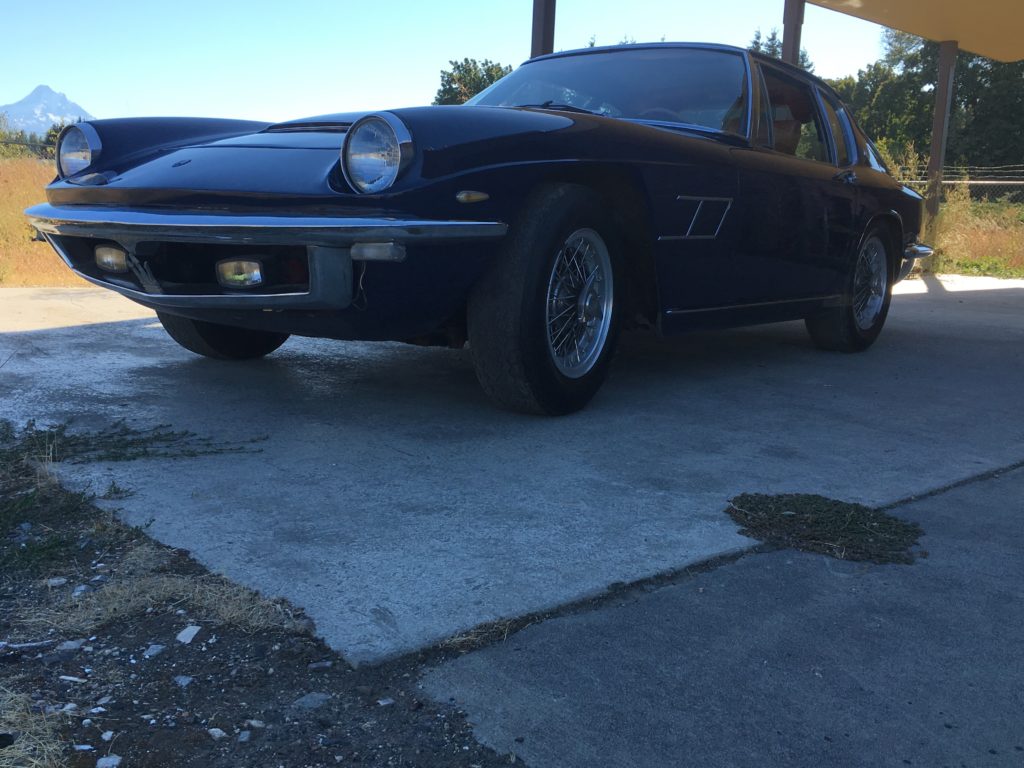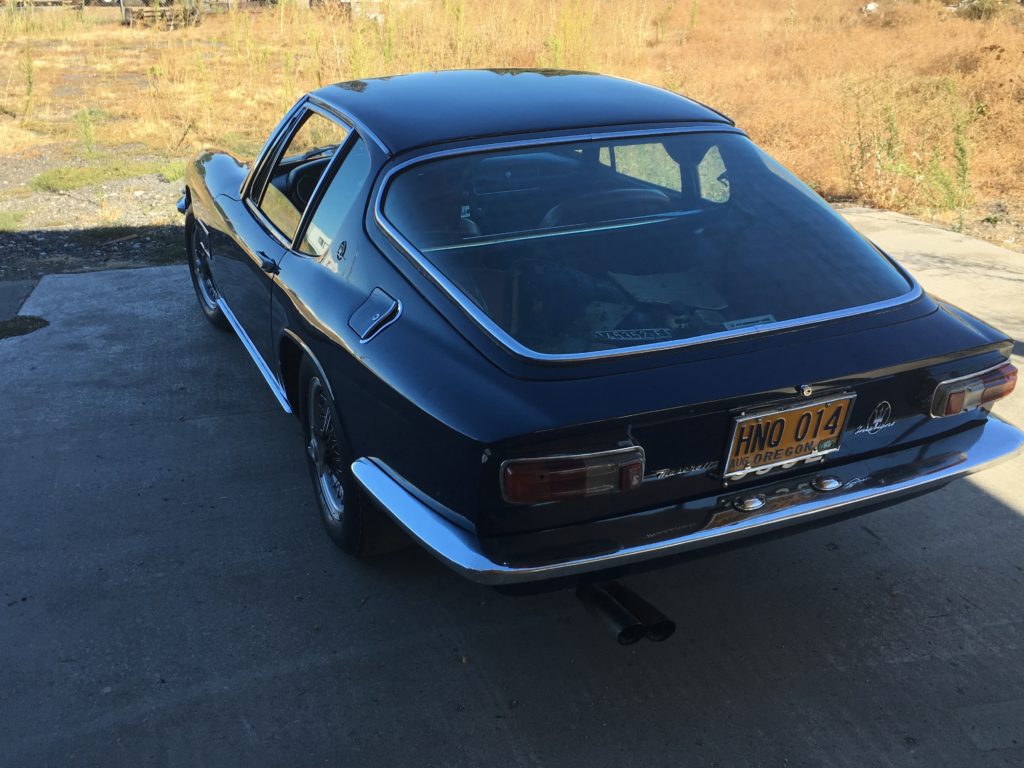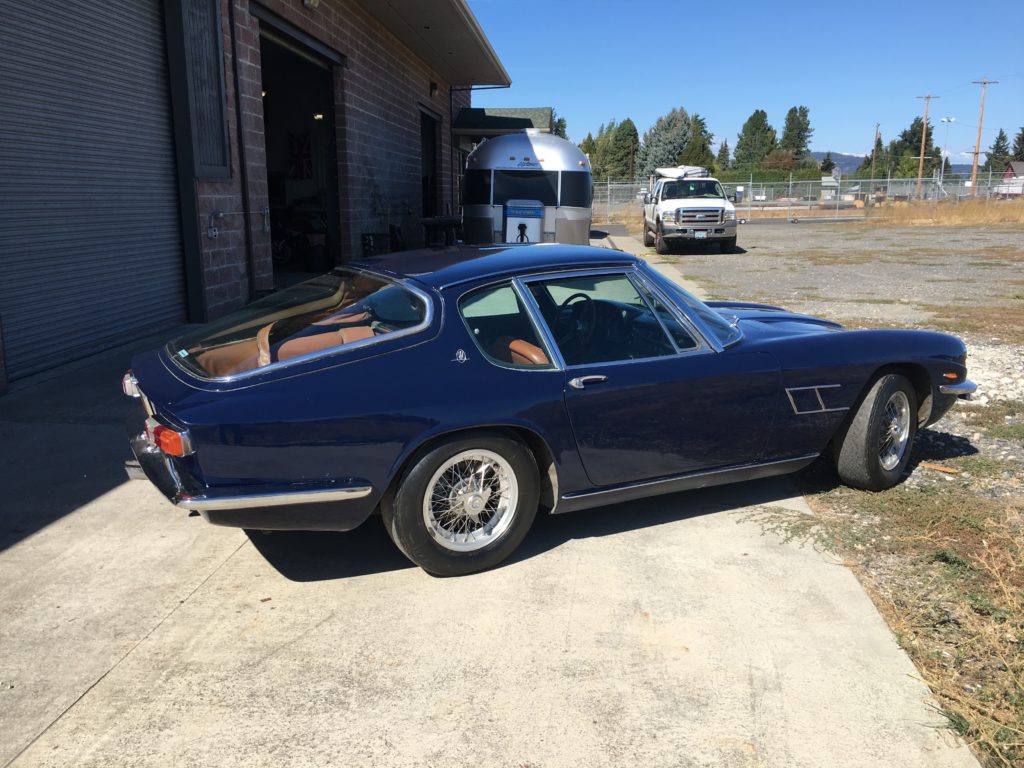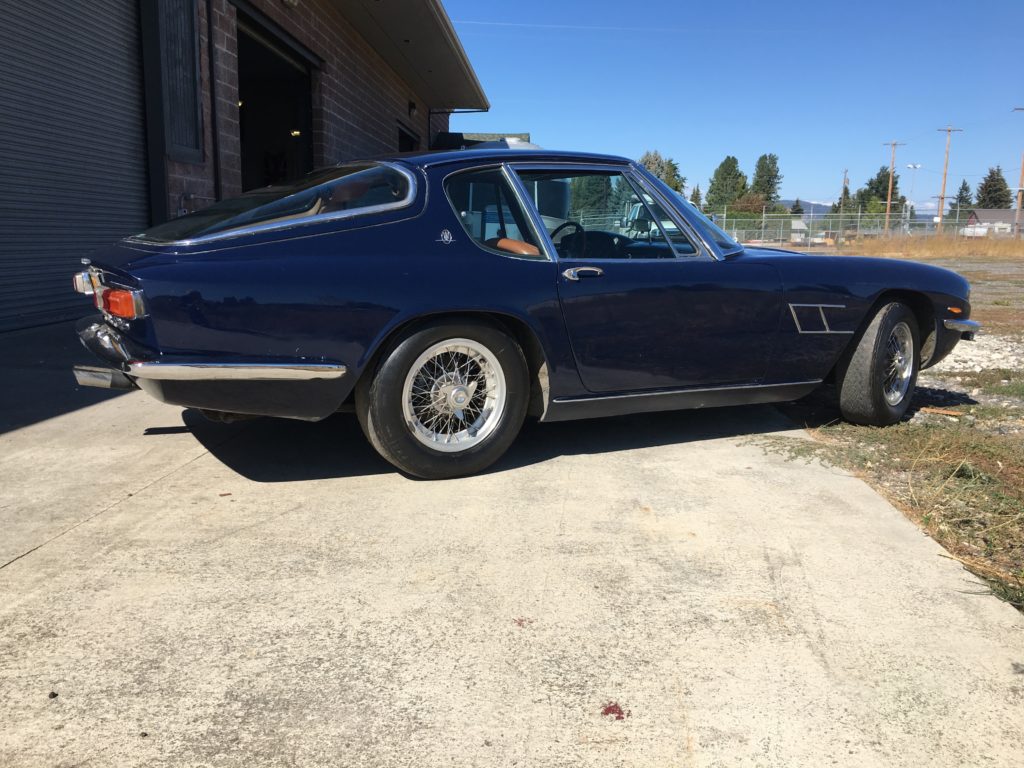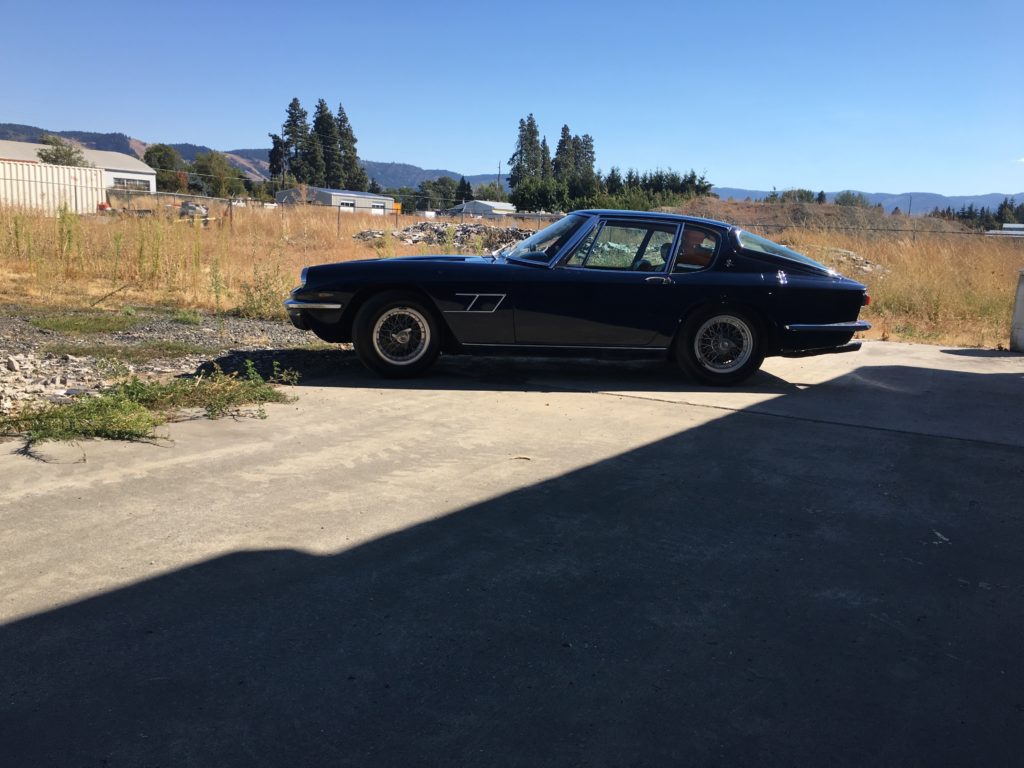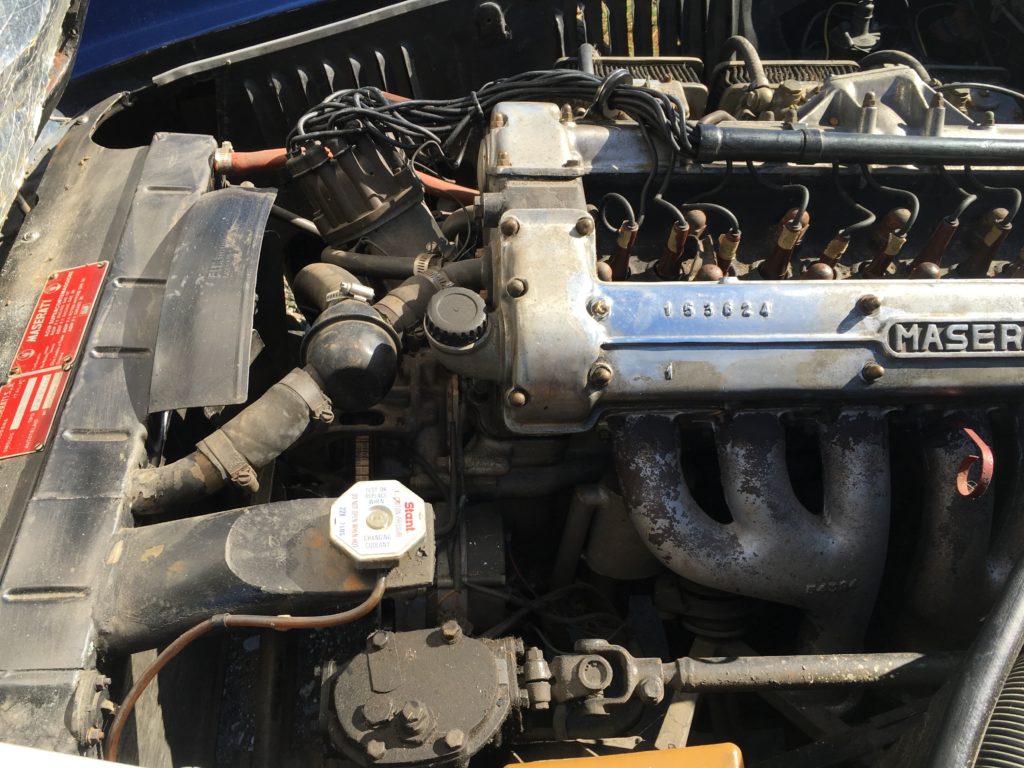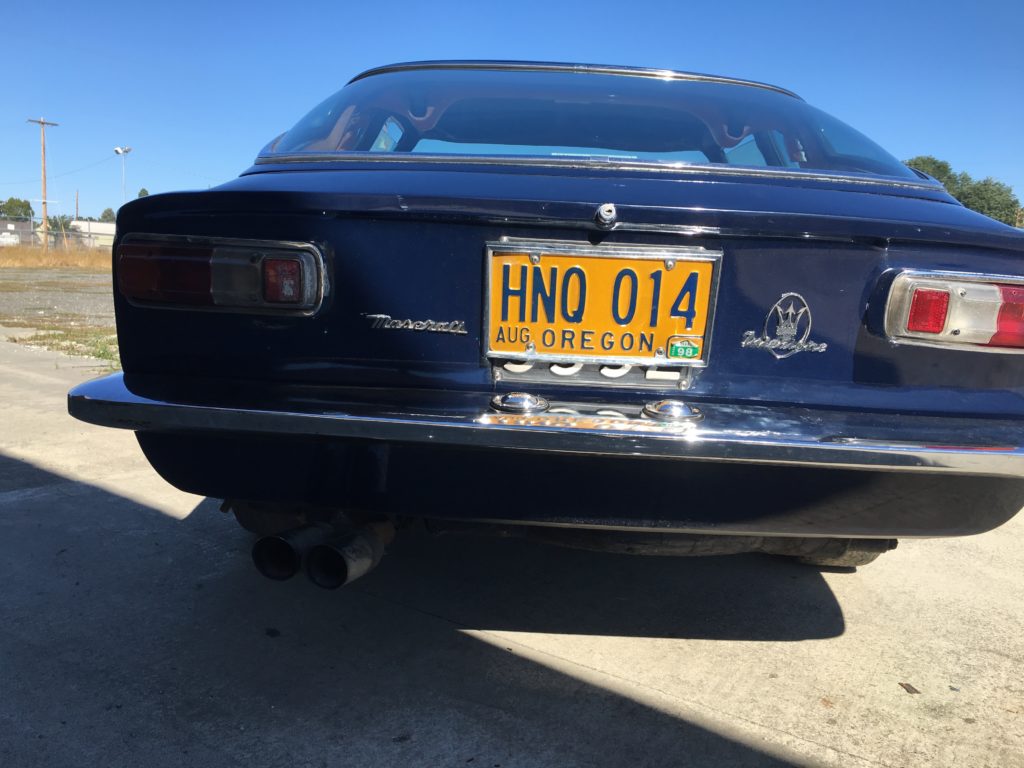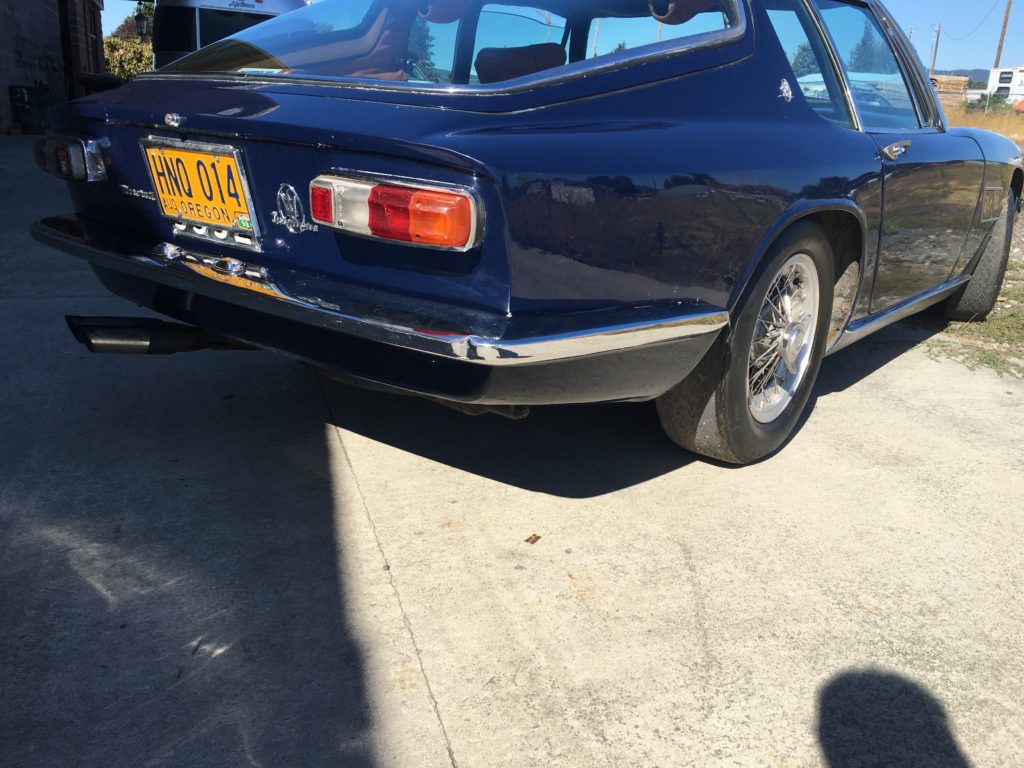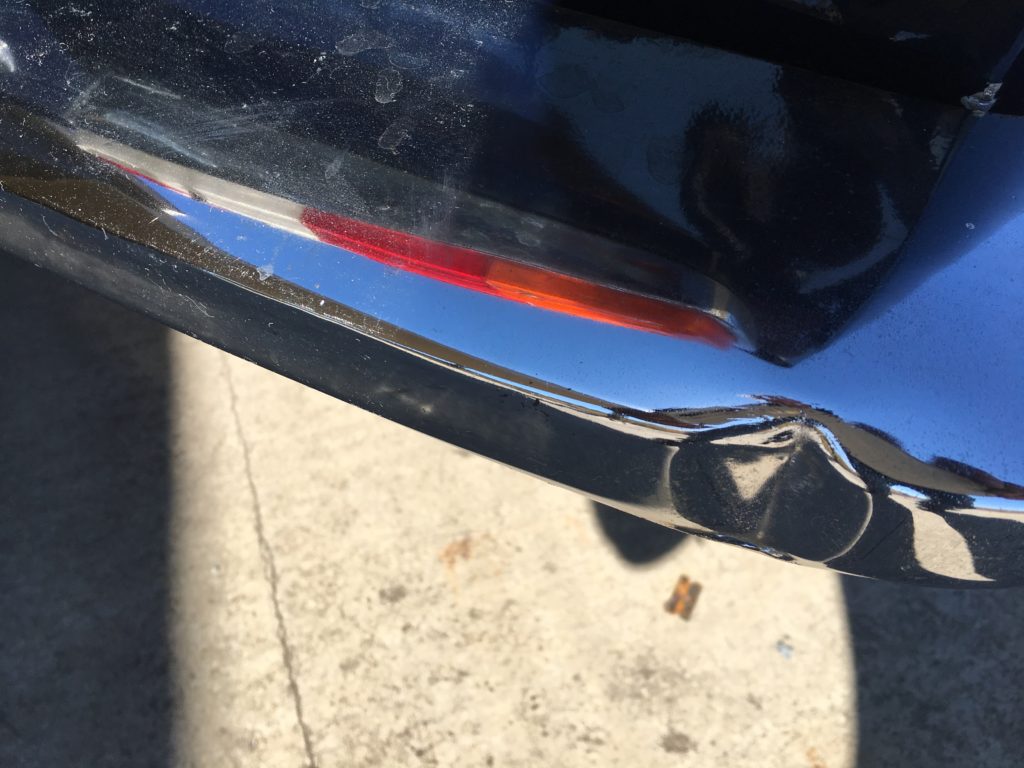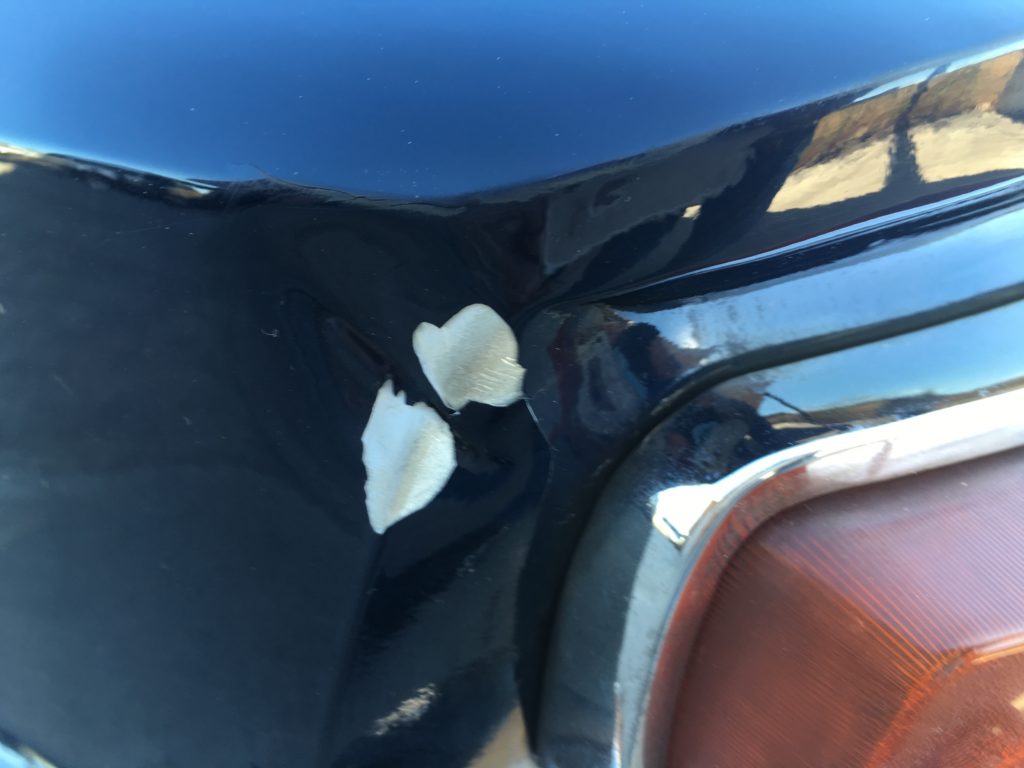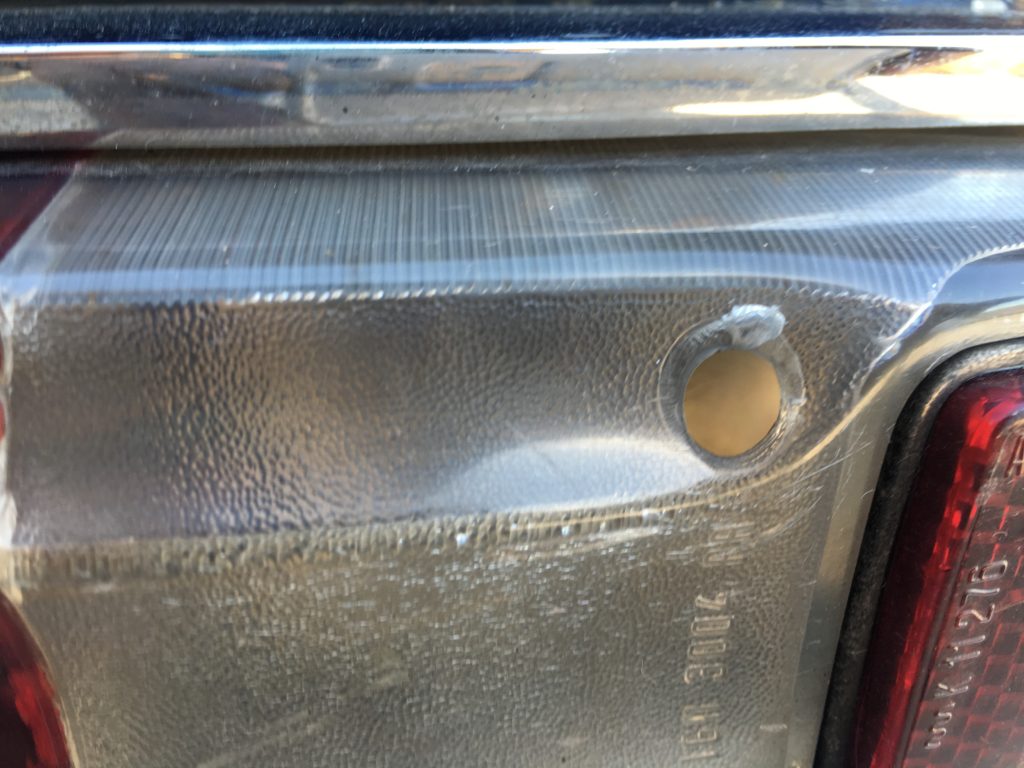About thirty years ago I was sitting in a barber chair, reading an article in a car magazine (I think it was Motor Trend) that said used exotic cars were selling for amazingly low prices. My imagination was fired by the notion of a Ferrari, Maserati or Aston Martin sitting in my garage. I certainly couldn’t afford a new one, but the software company I had co-founded with a friend as a side business to my real job was doing well. I could afford to spend 10 to 20 thousand on an inexpensive, old exotic car. I suspected I could maintain it though I expected a certain amount of drama and challenge. I’ve been wrenching on motorcycles and cars most of my life. I’m not great at it, but I’m good at it. I scoured Hemmings, looking for a car that looked right for me. I found a Ferrari 330 GTC in nice condition for about $20,000. An Aston Martin DB4 with a chevy motor for $10,000, and a 1968 Maserati Mistral just a few miles away from my home for $10,000.
The engine was out of the Maserati and completely disassembled, but the exterior was good, the interior was fair with some sections excellent. The guy who had pulled the motor said it would take about $2,000 to finish the rebuild and reinstall the engine. I bought the Mistral.
The main reason was the general specifications of the Mistral–it looked like a much better car than my other top choices. Disk brakes on all four wheels. A 4.0 liter, dual plug DOHC engine producing 245 HP. Coach-built aluminum body, a host of sophisticated touches to the engine design that seemed like better engineering–like the water/oil heat exchanger that warms the oil to operating temperature quickly and then cools it to keep it in an optimum range. A electro-magnetic clutch for the fan that regulates water temperature without consuming engine power. And I simply thought it was a better looking car. Lithe, sleek, and fabulous. Many people consider it to be the most beautiful car ever designed by the famous Pietro Frua of Turin, and the most beautiful Maserati.
Now it’s thirty years later, the Ferrari is close to a million in value and so is the DB4. And the Mistral? Not so much. My perception of it being the better car doesn’t translate to price. There aren’t many currently being sold, in part because there weren’t many produced (828 coupés worldwide between 1963 and 1970), but a solid driver seems to go for about $250,000. Jay Leno wrote an article in Octane recently where he wondered WTF was going on with Maserati prices. My memory sucks, but I think he was writing about a Mistral he has.
I drove it as it was for a year, and enjoyed the car greatly. The original paint was a light silver-blue, and the paint was sunburned a bit on the roof. I thought about getting it painted, but one night when I was pushing the car hard in some turns, I came around a corner and found a wide swath of muddy water covering the street. An irrigation pipe had broken. The car spun, slid across a long expanse of grass, and then hit a solid embankment at low speed. Low enough so I wasn’t injured, even though I was just wearing a lap belt, and low enough that there was no frame damage. But the soft aluminum nose was crumpled irreparably.
The tow truck dumped the car into my driveway, and I pushed it into a corner of the garage, trying to decide how to repair a coachbuilt body (one piece welded body–no panels and parts). I contacted a Maserati specialty shop in Washington state, and they told me they had a Mistral that had burned (more on this later). The back of the car was destroyed, but the nose was fine. I showed up with a Sawzall and a check, and cut the nose off the burned Mistral.
Back in Oregon, I cut away all the damaged metal, made jigs to hold the nose in place, and started trying to fit the puzzle pieces. I decided the job was beyond my capabilities and pushed the car to the back of the garage.
Time passed. My software company went out of business, I got divorced, and then started an advertising agency that became quite successful. Through all the moves and transitions I kept the Maserati, flat-towing it from one garage to another, always thinking that some day when I had the time, I’d restore it. Every few months I’d start the car and run it until the oil came up to stable temperature. A chance encounter put me in touch with a company in Eugene, Oregon called Panelbeaters. They were a very talented bunch, building complete new aluminum bodies from sheet metal. They agreed to do the job and we agreed on a price–about three time what I paid for the car in the first place. A painful decision, but I felt I owed it to the car. It was just too good to junk.
About a year later I got a call that my Maserati was finished and I had to come get it immediately. The owner of Panelbeaters was heading off to a job with the Ralph Lauren car collection and was closing the shop. I was worried that the work might have been hurried at the end, but when I got to Eugene I was floored. The body was flawless. Better than new. I had seen slight imperfections in the body originally, even with the light paint. With the dark blue paint, any irregularity would be obvious. But it’s gorgeous and the paint is spectacular. The dark blue paint may not be factory original, but it suits the car much better than the light silver blue.
This is 20-year-old paint. There’s a simple reason why it still looks so great–it’s hardly ever been outside.
The Borrani wheels are gorgeous. The chrome inner hubs have some corrosion, but most of it can be polished out. A specialist would make them look better than new, but anyone with time and some polish could make them look fantastic.

There are a few scrapes in the paint from when the bumper was refitted. Needs touch-up

One of the standards for fine bodywork is gap consistency. The clip that replaced the damaged nose started just about in line with the chrome lip. Not only is the repair undetectable in any way, but the gaps are perfect on the hood all the way around. I would never have been able to get that so perfect. Sorry about the cover fuzz.
But now the marginal interior was much too tatty to be tolerated, and some of the leather had shrunk. The conundrum was that a lot of the interior was in excellent shape, with a fine patina that new upholstery would take decades to acquire. I needed someone to replace just the unusable interior elements and save the good parts. I’m still looking.

I pulled the covers off the inner fenders to access the fuel tanks. The upper strip is shrunken and perished, but the cover itself might be salvageable

The headliner and leather bolsters are in remarkably good shape. there was a time that restoration would have meant ripping all this out and replacing it with new, but I think that would be a shame.

Wheel well covers are lovely. A little stained and scuffed, but so am I. It’s lovely patina.

The bad and the good–the seat backs are terrible, the seat cushion is a Naugahyde replacement (dumb) but the little vestigal seats in back (who fits in those??) are perfect.

Menehune seats and cargo cover for them.

Dashboard is great.

There’s some split stitching (about an inch) over the glove compartment that’s an easy repair.
 There’s a spot on the leather to the right of the mirror where something hot looks to have been laid, but other than that it’s in fine shape.
There’s a spot on the leather to the right of the mirror where something hot looks to have been laid, but other than that it’s in fine shape.

I don’t think the door panels were this bad when I pulled them off twenty years ago.
There were also three other projects that I wanted to complete before I started using the car again. The electric window winders have teeth missing at the end of travel when the window is fully down. I wanted to rebuild those, so I took the doors apart and started looking for someone to repair them. The gas tanks (there is one in each of the rear fenders) have a crossover pipe that can pull loose much too easily. I know why some Maseratis burned up–the pipe is just rubber hose with hose clamps and no retaining bubble on the hard pipe of the tank. That needed to be replaced with a much more secure crossover. I planned to fabricate that with Aeroquip hose and AN fittings.
And finally the enormous oil sump seems to have no effective baffling. The car starves for oil in long hard turns. Better baffling and/or an accusump accumulator was needed.

Door panels and window mechanism removed for repair.

Twenty years ago repairing these segment gears was going to be a bitch. Now I’d have them scanned and cut with a water jet.
I had a plan, I had a list, and then a really nice custom M6 BMW came my way. So the Maserati got pushed to the back of the garage with a nice car cover on it. More years went by, the Maserati got moved around as projects came and went. I was getting ready to dive into the restoration when I got interested in vintage car racing. Built a TR3 to race but I went much too far with the modifications (Rules? There are rules?), bought a TR3-based special called Peyote. The Mistral got rolled back and covered. I got serious again, but I bought a Ferrari 355 Spider and the Mistral got rolled back.
More time passed, I retired, and moved to Hood River, Oregon. I bought a shop building and started working my way through the many projects I have. I’ll be 70 next year, time to get some of this stuff done. But last week when I was backing my race car up to load it in the trailer, I backed into the Maserati. It’s minor damage, nothing that any decent painter can’t fix, but it’s the straw that broke the camels back.

My race car is named Peyote. When it turned 50 we had a birthday party for it at Portland International Raceway, and I made buttons that read, “A little Peyote never hurt anyone”. I guess that doesn’t apply to Maseratis. This really pissed me off.

I look at all the projects I have to do, most of which are well within my limited capabilities, and I figure I need to live to be 120 to finish them all. The Maserati is just not going to happen.
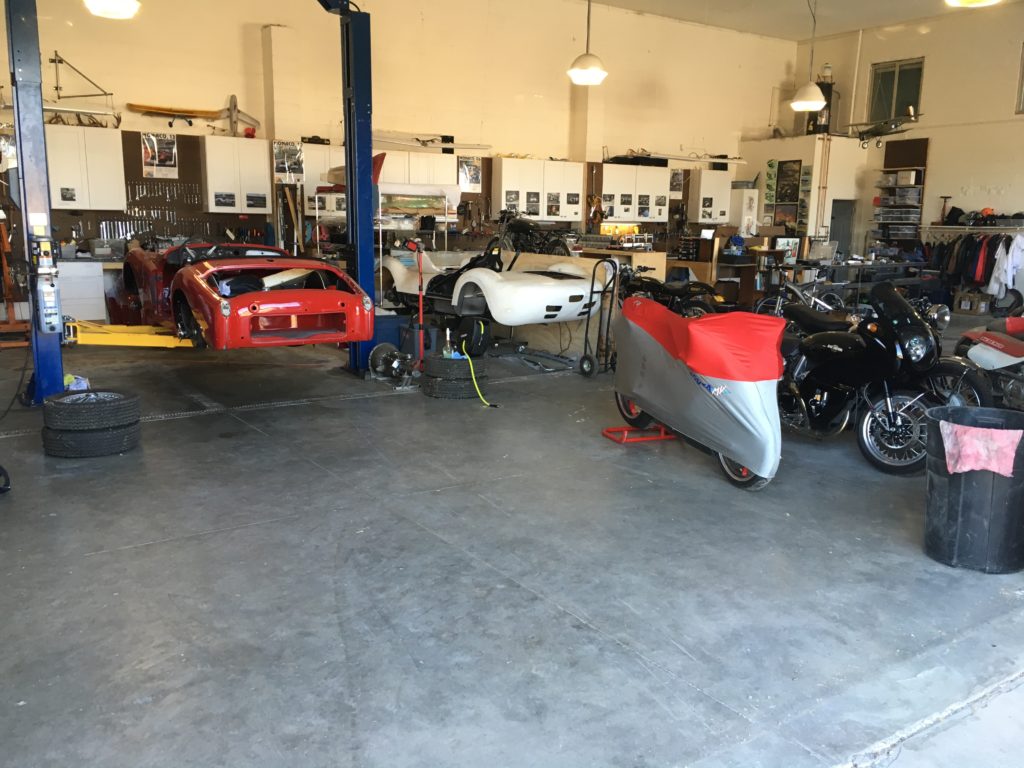
I have plenty of projects to keep me busy, there’s about 20 years worth right here.
My wife says “It’s a beautiful car, nice to have just to look at. Why would you sell it? You don’t have to do anything with it, just put it in an out of the way spot and enjoy it.”
I can’t do that. Anyone who has bothered to read this far knows why.
So I’m going to sell it. I’ve submitted it to Bring A Trailer, a publication that I’ve always enjoyed. I expect that they will accept it. It’s a pretty cool car and will be an amazing project for someone who has the skills and time to finish it.
What’s it worth? Not a clue. I know what I have into it–about $45K in 1980 dollars. According to an inflation calculator, that’s $138,769.56. Storing it and pushing it around for all those years? Who knows. Thinking about that kind of puts all those notions about saving cars as an investment into perspective–it’s not a free ride. There’s a reason vintage cars cost a lot these days–beyond the lack of equally enjoyable “investments” that is.
For the right person this will be a fairly easy restoration and will result in a spectacular car. I hope the right person gets it. But it’s not me.
***Update*** My Maserati sold on Bring A Trailer for 117,000 after some very spirited and exciting bidding. It’s been shipped to Asia to restore it to service. All the best to the new owner, and no, I never found the keys. Sorry.
People have asked if the engine turns freely. Here’s a video of me cranking it:
The engine turns smoothly. The effort evident in the video is turning the engine against compression.
More pictures in no particular order:
Yes, the spare is a Borrani wheel. It looks to be unused, both because of how clean the inner rim is and how unmarked the splines are. 




Water pump with concentric shaft electromagnetic clutch
Number 600 of 828
Gas cap cover chips
Hood gaps are perfect. No, that isn’t a chip on the edge of the hood, just the reflection of my bald head
Door gaps are perfect. They weren’t this good originally Panelbeaters made them right.
The chrome polishes right up.
Polished vs. unpolished. A few moments of effort. I should do the whole car, but then I’d want to do the wheels. Nah.
This is the only bad bit of outside chrome. The roller tube for the luggage cover has rust at the ends.
Needs attention
Bumper ding
Peyote ding. Damn!
Taillight lens on the left side needs some work. These are hard to get and expensive, but this is repairable.
Undercarriage: One of the Bring A Trailer members asked to see some undercarriage shots. So I put the car on my lift this morning and took these. Been a while since I’ve been under this thing.

Wheel wells, and all the exposed metal under the car is coated with an undercoating material. The wheel wells are aluminum.

There’s some flaking of the undercoat material but the metal underneath is in fine shape

The body under the lower edge door trim is a rubbery undercoat sort of material that is painted the body color.

Wheel well and lower edge of body.
There’s a little corrosion on the bumper under the edge. I should have tried polishing it out. Also some scapes in the aluminum apron–curb rash. You can see that the superleggra framework supporting the nose was undamaged in the accident. It was a low speed incident that crumpled aluminum and nothing much else. Didn’t even disturb the radiator but it sure wadded up the aluminum.
The rubber bushings that the roll bar is fixed to are perished, but still flexible
The undercoating on the frame tubes is intact and well adhered. The huge sump under the engine is remarkably unscraped.
A little undercoat flacking on this frame tube.
Suspension detail

Underneath the rear bumper. Most of the frame is covered by the aluminum belly pan, which is undercoated. The spare recess in the trunk is solid, the battery box needs refurb. I should have pulled that old battery out twenty years ago.
Rear springs are in good shape, the leather “anti-squeak” panels are still in place.

Corroded battery box

The wimpy stop strap on the left side is intact.

The one on the right side is broken. I’d replace these with some heftier webbing.
Exhaust system is done for. I tried to get a shot of the header but couln’t manage it–it’s in good condition. You can see in the engine bay shots that the header is a heavy casting in good condition.

Undertray and exhaust. The exhaust system should be replaced up to the header. The header is fine.
Flaked undercoating in rear wheel well. Aliminum underneath the undercoat. It appears the undercoating doesn’t stick to the aluminum as well as it does to steek.

Front suspension is undamaged and shows no corrosion

Suspension stop is checked on the surface, but is solid and flexible, roll bar grommets are toast but intact.

Parking lot scrape. Gotta watch those curbs.

Engine sump–not a mark on it. Surprising. Floor pans have some scarpes and dents but are intact and good.
Belly pan

Cracked section in the drivers side belly pan.
Dented section, driver’s side belly pan.


Fuel lines


